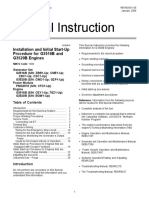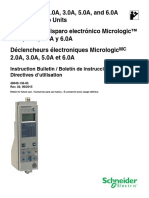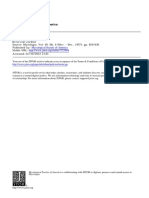Light Load Operation Perkins
Light Load Operation Perkins
Uploaded by
Falgon IslamCopyright:
Available Formats
Light Load Operation Perkins
Light Load Operation Perkins
Uploaded by
Falgon IslamOriginal Description:
Copyright
Available Formats
Share this document
Did you find this document useful?
Is this content inappropriate?
Copyright:
Available Formats
Light Load Operation Perkins
Light Load Operation Perkins
Uploaded by
Falgon IslamCopyright:
Available Formats
Perkins Engines Company Ltd
Tixall Road
Stafford
ST16 3UB
United Kingdom
Light Load Operation on Diesel Engines
If an engine is operated on load less than 25-30% of it’s rated output, certain symptoms will be
observed which may cause for concern. The engine is designed to run up to a maximum power and
so the size of the piston, the wall loading of the piston rings, etc., are designed to cope with this.
When an engine is run at light load then the energy put into the cylinder is low and consequently the
cylinder pressure is lower and so is the temperature. The result is the piston is not such a good fit in
the bore, with increased clearanced, allowing more oil to pass the piston and be burnt, which is
indicated by high oil consumption.
With lower preasures the sealing capacity of the rings is lower, also it is not ideal for bedding in the
rings and can cause bore glazing, which ruins all control.
On turbocharged engines oil will start to appear from the manifolds from the bearing arrangement in
the turbocharger.
Turbochargers are fitted to an engine to increase power by supplying more air to the cylinders. When
running a turbocharger, air is sucked in, which can have vacuum levels up to 500kPa, with pressure
ratios of 3 : 1. The compressor seals are designed to work most efficiently when the turbocharger
compressor is operating at its’ most efficient point. If the engine is running at low powers then the
turbocharger is running at low speed (no energy from the exhaust because the fuel inlet to the engine
is low) and the inlet vacuum is low resulting in poor turbocharger seal loading and pull over of oil from
the bearing assembly. This oil is mixed with the air and pumped into the manifolds where some
separates from the air when it collides with the inside of the manifold. If the joints are not air tight the
oil will leak out.
Black smoke will be produced from the exhaust outlets, due to poor combustion at light load, as
excess fuel is pumped through into the exhaust system, resulting in soot being expelled into the
exhaust system.
A further result is that abnormal carbon build-up on the valves, piston crowns and exhaust ports. Thus
the normal service interval between top overhauls may be reduced. Fuel dilution of the lubricating oil
will also occure.
It is therefore recommended that the following precautions are observed :-
• Running on light load should be avoided or reduced to a minimum period. If weekly exercising on
no load is carried out, the running period should be kept down to maximum 15 minutes or until the
battery charge rate returns to normal.
• Every year the engine / generating set should be run on full load for four (4) hours, to burn off
accumulations of carbon in the engine and exhaust system. This may require a “dummy” load.
The load should be built-up gradually from zero over the four hour run.
You might also like
- Operation & Maintenance Manual: (MGS 7310 GCP)Document47 pagesOperation & Maintenance Manual: (MGS 7310 GCP)Falgon IslamNo ratings yet
- IC NT 2 5 3 New Features ListDocument17 pagesIC NT 2 5 3 New Features ListMaxiSanchez100% (1)
- 2206a-E13tag3 Electropak Pn1881Document2 pages2206a-E13tag3 Electropak Pn1881ibrahemNo ratings yet
- 4008-30TAG3 TPD2011E2 Nov2015Document5 pages4008-30TAG3 TPD2011E2 Nov2015tienlamNo ratings yet
- Cummins Connect SeriesDocument24 pagesCummins Connect SeriesLemoj SerapseNo ratings yet
- Operation & Maintenance Manual: (MGS 560 Panel)Document53 pagesOperation & Maintenance Manual: (MGS 560 Panel)Falgon IslamNo ratings yet
- Adnexal Masses - Ovarian Cysts (2008)Document23 pagesAdnexal Masses - Ovarian Cysts (2008)Michelle Fynes100% (1)
- Chapter 9Document130 pagesChapter 9Andy ChauNo ratings yet
- Himoinsa BrochureDocument12 pagesHimoinsa BrochurePowerTechNo ratings yet
- Matin Spinning 1XG3512H RDocument11 pagesMatin Spinning 1XG3512H RNazrul IslamNo ratings yet
- 315GFBA - QSK19G DatashhetDocument5 pages315GFBA - QSK19G DatashhetedilbertoNo ratings yet
- X2500 GeneratorDocument5 pagesX2500 Generatordon121don121No ratings yet
- Mitsubishi Diesel Engine Technical Information: Specification Sheets of S12H-PTA EngineDocument4 pagesMitsubishi Diesel Engine Technical Information: Specification Sheets of S12H-PTA EngineFalgon Islam100% (1)
- CT365 CT400S (QSG12 50Hz)Document3 pagesCT365 CT400S (QSG12 50Hz)Md ShNo ratings yet
- 4008TESI LC Spark Gas Cogen Tech DataDocument6 pages4008TESI LC Spark Gas Cogen Tech Datadwi monikaNo ratings yet
- S285 Fozmula Capacitance Coolant Level Switch Data JP 24 Nov 15 3.1 Rev 2 PDFDocument1 pageS285 Fozmula Capacitance Coolant Level Switch Data JP 24 Nov 15 3.1 Rev 2 PDFfaraidun0% (1)
- 4008 30TRS1Document16 pages4008 30TRS1Ben ZithaNo ratings yet
- Generator Control Panels - FG WilsonDocument1 pageGenerator Control Panels - FG WilsonAnd jazNo ratings yet
- General Characteristics: DescriptiveDocument5 pagesGeneral Characteristics: DescriptiveAnh Nguyen100% (1)
- Dse 509Document2 pagesDse 509SOSNo ratings yet
- DetCon2 InstalacionDocument14 pagesDetCon2 InstalacionMaia Naiara BarrientosNo ratings yet
- برند های مورد تایید طرشتDocument4 pagesبرند های مورد تایید طرشتppourmoghaddam100% (1)
- FG Wilson P165-1 (4PP) GB (0213)Document4 pagesFG Wilson P165-1 (4PP) GB (0213)harikrishnanpd33270% (1)
- MWM Deutztool-SetsDocument1 pageMWM Deutztool-SetsREZA ASGARINo ratings yet
- C32 Syc03519 - PSRPT - 2019-11-06 - 17.53.14 PDFDocument4 pagesC32 Syc03519 - PSRPT - 2019-11-06 - 17.53.14 PDFiprahim202066100% (1)
- CDocument620 pagesCHung Cuong PhamNo ratings yet
- Volvo Penta D12-Short SpecDocument4 pagesVolvo Penta D12-Short Speczulu800% (1)
- Electropak: 1206A-E70Ttag2Document4 pagesElectropak: 1206A-E70Ttag2Andres SorinNo ratings yet
- 1100 Series PerkinsDocument2 pages1100 Series PerkinsGilberto Diaz CastilloNo ratings yet
- Deep Sea Electronics: Model 5220 Installation and Configuration InstructionsDocument2 pagesDeep Sea Electronics: Model 5220 Installation and Configuration Instructionsdhani_is100% (1)
- Perkins 750KVA-825KVADocument4 pagesPerkins 750KVA-825KVAHải Nguyễn HồngNo ratings yet
- ACS Analogue Control Systems eDocument12 pagesACS Analogue Control Systems eKhaled KamelNo ratings yet
- N45sm1a 51 To 59KWDocument3 pagesN45sm1a 51 To 59KWsaiyedasadNo ratings yet
- EMCP 4.4 Upgrade KitDocument1 pageEMCP 4.4 Upgrade KitMosa Elnaid ElnaidNo ratings yet
- Mhi Marine Warranty PDFDocument4 pagesMhi Marine Warranty PDFTruong Nguyen Thanh100% (1)
- Installation and Operation Manual: Proact™ Itb Integrated Actuator and Throttle BodyDocument26 pagesInstallation and Operation Manual: Proact™ Itb Integrated Actuator and Throttle BodyNimNo ratings yet
- Data Sheet: Diesel Generator 1320Kw 50HZ/1500RPM PERKINS MODEL: 4012-46TAG2ADocument11 pagesData Sheet: Diesel Generator 1320Kw 50HZ/1500RPM PERKINS MODEL: 4012-46TAG2Alahcen boudaoudNo ratings yet
- Special Instruction: Installation and Initial Start-Up Procedure For G3516B and G3520B EnginesDocument28 pagesSpecial Instruction: Installation and Initial Start-Up Procedure For G3516B and G3520B EnginesDiego Ruben Palavecino100% (1)
- General: Technical Data TAD721GEDocument8 pagesGeneral: Technical Data TAD721GEbaljeetjatNo ratings yet
- Micrologic 2.0A PDFDocument154 pagesMicrologic 2.0A PDFGabriel ZorattiNo ratings yet
- S 1250AJP JLG Service EnglishDocument788 pagesS 1250AJP JLG Service Englishmilandilov100% (1)
- Excitation Module: Features Worldwide Product SupportDocument5 pagesExcitation Module: Features Worldwide Product SupportIBRAHIM AL-SURAIHINo ratings yet
- Cat Electronic Modular Control Panel (EMCP) 4.3 Upgrade KitDocument2 pagesCat Electronic Modular Control Panel (EMCP) 4.3 Upgrade KitKaung KharNo ratings yet
- Basler Electric DGC-2020HD User ManualDocument26 pagesBasler Electric DGC-2020HD User Manualnicholas_edwinNo ratings yet
- Kirloskar Brushless AlternatorDocument34 pagesKirloskar Brushless AlternatorAmit Kumar VishwakarmaNo ratings yet
- EAM Interface - Quick Reference: Interface Model Description GAC Product Information Bulletin Wiring DiagramDocument3 pagesEAM Interface - Quick Reference: Interface Model Description GAC Product Information Bulletin Wiring DiagramibrahemNo ratings yet
- RENR7941 - CDVR SpecificationDocument4 pagesRENR7941 - CDVR SpecificationХусниддин ГаниевNo ratings yet
- Deep Sea Electronics: DSEP100 Configuration Suite PC Software ManualDocument30 pagesDeep Sea Electronics: DSEP100 Configuration Suite PC Software ManualalexanderNo ratings yet
- Kea 071 AnlDocument12 pagesKea 071 Anlamin shirkhaniNo ratings yet
- C18 Generator Set STM00001-UP (SEBP4100 - 43) Procedure For Installation of VR6 Voltage RegulatorDocument9 pagesC18 Generator Set STM00001-UP (SEBP4100 - 43) Procedure For Installation of VR6 Voltage RegulatorCEVegaO100% (1)
- Technical Data TAD741GE: Including Radiator and IntercoolerDocument4 pagesTechnical Data TAD741GE: Including Radiator and IntercoolerbaljeetjatNo ratings yet
- SFGLD240Document2 pagesSFGLD240Pankaj KambleNo ratings yet
- Jean Muller, Fuse Reating PDFDocument46 pagesJean Muller, Fuse Reating PDFhizbi7No ratings yet
- China Nonroad EmissionsDocument6 pagesChina Nonroad Emissionsmazumdar_satyajitNo ratings yet
- 2301A Electronic Load Sharing and Speed Controls Installation and Operation ManualDocument51 pages2301A Electronic Load Sharing and Speed Controls Installation and Operation ManualJoseMalaveNo ratings yet
- Service Manual: Mitsubishi GAS EngineDocument68 pagesService Manual: Mitsubishi GAS Engine27scribdNo ratings yet
- ATyS C55Document110 pagesATyS C55David MonederoNo ratings yet
- Dvigatel Perkins 4016 61trg3Document14 pagesDvigatel Perkins 4016 61trg3mohammed khadrNo ratings yet
- Detroit 92Document2 pagesDetroit 92Nurhamzah KrisnasaktiNo ratings yet
- PMB7040 C Catalog Web PDFDocument16 pagesPMB7040 C Catalog Web PDFRached Douahchua0% (1)
- TSI ParametersDocument10 pagesTSI ParametersRath Asypaden50% (2)
- Td520ge PDFDocument11 pagesTd520ge PDFThanapong Usupan100% (1)
- Overhead Set (OBC) k50Document24 pagesOverhead Set (OBC) k50julian ienNo ratings yet
- Motor A Baja Carga Light Load Operation On Diesel EnginesDocument3 pagesMotor A Baja Carga Light Load Operation On Diesel EnginesJermaine PeñaNo ratings yet
- Untitled SpreadsheetDocument23 pagesUntitled SpreadsheetFalgon IslamNo ratings yet
- Sheet No 12Document30 pagesSheet No 12Falgon IslamNo ratings yet
- Operation & Maintenance Manual: Issued: March 2021 Pub. No. 29A01-00120 Revision: 1Document123 pagesOperation & Maintenance Manual: Issued: March 2021 Pub. No. 29A01-00120 Revision: 1Falgon IslamNo ratings yet
- Operation & Maintenance Manual: (S16R2-PTAW2-S)Document111 pagesOperation & Maintenance Manual: (S16R2-PTAW2-S)Falgon IslamNo ratings yet
- FLX30d: Spare Parts CatalogueDocument49 pagesFLX30d: Spare Parts CatalogueFalgon IslamNo ratings yet
- Filter Offer PaikaneDocument1 pageFilter Offer PaikaneFalgon IslamNo ratings yet
- Operation & Maintenance Manual: (MGS 7310 GCP)Document47 pagesOperation & Maintenance Manual: (MGS 7310 GCP)Falgon IslamNo ratings yet
- Spare Parts Catalogue: Handling Systems - Counter Balance Forklift TruckDocument12 pagesSpare Parts Catalogue: Handling Systems - Counter Balance Forklift TruckFalgon IslamNo ratings yet
- Service BulletinDocument1 pageService BulletinFalgon IslamNo ratings yet
- Service BulletinDocument4 pagesService BulletinFalgon IslamNo ratings yet
- Service BulletinDocument3 pagesService BulletinFalgon IslamNo ratings yet
- Service BulletinDocument1 pageService BulletinFalgon IslamNo ratings yet
- Service BulletinDocument1 pageService BulletinFalgon IslamNo ratings yet
- Service BulletinDocument1 pageService BulletinFalgon IslamNo ratings yet
- Service BulletinDocument1 pageService BulletinFalgon IslamNo ratings yet
- Service BulletinDocument7 pagesService BulletinFalgon IslamNo ratings yet
- M19 856 eDocument1 pageM19 856 eFalgon IslamNo ratings yet
- Service BulletinDocument21 pagesService BulletinFalgon Islam100% (1)
- Service BulletinDocument1 pageService BulletinFalgon Islam100% (1)
- Service BulletinDocument1 pageService BulletinFalgon Islam100% (1)
- M19 859 eDocument2 pagesM19 859 eFalgon IslamNo ratings yet
- Service BulletinDocument2 pagesService BulletinFalgon IslamNo ratings yet
- Numerical On Latitudes and DeparturesDocument2 pagesNumerical On Latitudes and DeparturesAnkit MaliNo ratings yet
- Earth Sci Initial Release June 14 PDFDocument170 pagesEarth Sci Initial Release June 14 PDFJesha mae MagnoNo ratings yet
- Srisailam HPSDocument4 pagesSrisailam HPSN. Sasidhar100% (1)
- Design and Analysis of Wheel Rim Using CATIA & ANSYSDocument7 pagesDesign and Analysis of Wheel Rim Using CATIA & ANSYSankitsinghal54No ratings yet
- Acne Scarring Management - Systematic Review and Evaluation of The EvidenceDocument19 pagesAcne Scarring Management - Systematic Review and Evaluation of The EvidenceigorfragaNo ratings yet
- Multimetro PromaxDocument1 pageMultimetro PromaxMiguelDelBarrioIglesisasNo ratings yet
- Median Ink FebruaryDocument4 pagesMedian Ink FebruaryYad ZanaNo ratings yet
- ESC102 CH 5Document73 pagesESC102 CH 5EMJAYNo ratings yet
- Immunization StatusDocument21 pagesImmunization StatusAubery RongNo ratings yet
- Minimum Viable Population Sizes (Shaffer, 1981)Document5 pagesMinimum Viable Population Sizes (Shaffer, 1981)Luan FonsecaNo ratings yet
- Final MSSQLDocument6 pagesFinal MSSQL8020 Sakshi100% (1)
- Algoritma Diagnosis AnemiaDocument2 pagesAlgoritma Diagnosis AnemiaathrahrNo ratings yet
- Basic Principles of MagnetsDocument24 pagesBasic Principles of MagnetsMarife GuadalupeNo ratings yet
- Leakage Detection Using Fiber Optics Distributed Temperature MonitoringDocument8 pagesLeakage Detection Using Fiber Optics Distributed Temperature MonitoringeochiufpicNo ratings yet
- Safe Handling of Hazardous ChemicalsDocument2 pagesSafe Handling of Hazardous ChemicalsFilipNo ratings yet
- Developmental Disabilities and Their Management / Orthodontic Courses by Indian Dental AcademyDocument71 pagesDevelopmental Disabilities and Their Management / Orthodontic Courses by Indian Dental Academyindian dental academyNo ratings yet
- Appendix 1 URS For Isolator and Safety Cabinets PDFDocument31 pagesAppendix 1 URS For Isolator and Safety Cabinets PDFRND BiotisNo ratings yet
- Burn - WikipediaDocument31 pagesBurn - WikipediaJanice ScatesNo ratings yet
- Transcript JiratDocument2 pagesTranscript JiratJirat ArsanorkNo ratings yet
- ISC 2019 F ListDocument5 pagesISC 2019 F ListAvijitSinharoyNo ratings yet
- 2017 Supercritical Carbon Dioxide Cycles For Power Generation A ReviewDocument32 pages2017 Supercritical Carbon Dioxide Cycles For Power Generation A Reviewjing qiangNo ratings yet
- Fig 9. Maximum Safe Operating Area Fig10. Effective Transient Thermal ImpedanceDocument2 pagesFig 9. Maximum Safe Operating Area Fig10. Effective Transient Thermal ImpedanceMarck SolterNo ratings yet
- Carmichael 1957Document12 pagesCarmichael 1957Anhar AnharNo ratings yet
- Echoes Spring 2019Document46 pagesEchoes Spring 2019mattlaneNo ratings yet
- RAC Lecture 3 Applications of Refrigeration Air ConditioningDocument20 pagesRAC Lecture 3 Applications of Refrigeration Air ConditioningBryan ScofieldNo ratings yet
- GC University Lahore Department of EnglishDocument2 pagesGC University Lahore Department of Englishsyed ahmadullahNo ratings yet
- Article - The Game Plan For Aligning The Organization - Kelley School of BusinessDocument13 pagesArticle - The Game Plan For Aligning The Organization - Kelley School of BusinessTONI EBERT HUALI VILLANo ratings yet
- Filter DesignDocument6 pagesFilter Designnaga7389No ratings yet

















































































































